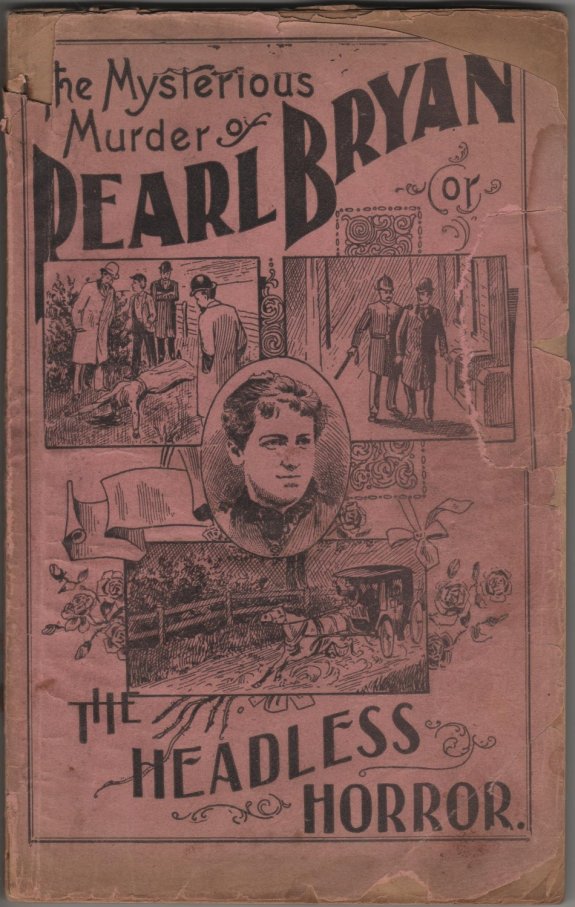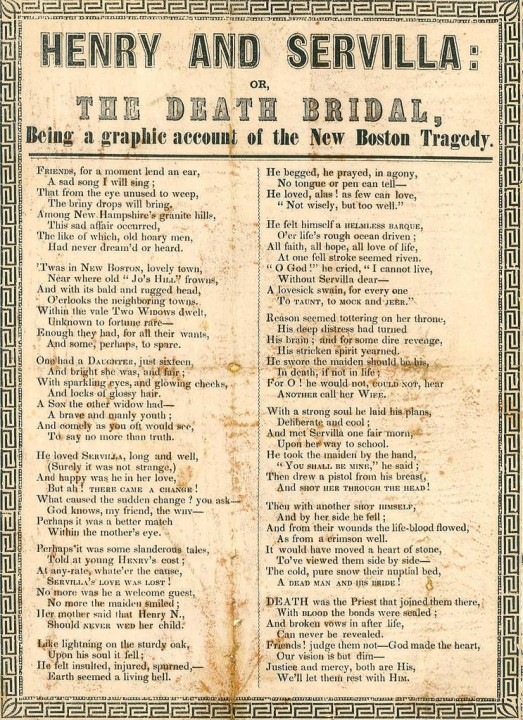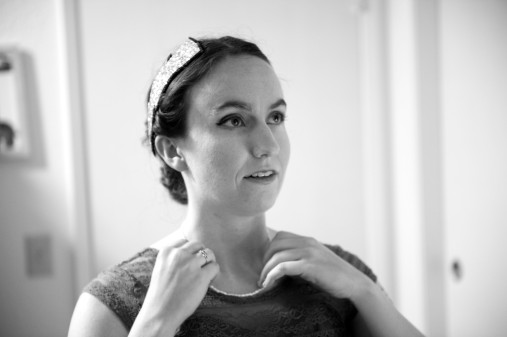By Sam Wall
I’m fascinated by murder ballads. They intrigue me with the way they mix beauty and grotesquery. I love how they show us that the cultural obsession in the U.S with murder did not start with O.J Simpson or “Making of a Murderer.” Our fascination with bloodshed is deeply ingrained in our folklore and songs, songs that attract the slice of my attention reserved for all things morbid. On top of being a lover of the macabre, I’m also a feminist killjoy who loves pointing out the ways in which gender interacts with cultural storytelling. That overlap in interests is how I noticed that murder ballads tell us a great deal about domestic violence, and offers clues to how much (or how little) our conversations about it changed over the course of a century.
Murder ballads take all sorts of forms, from gallows confession to the chronicles of wild west outlaws. For our purposes, a murder ballad is any song telling the story of one person killing another. While murder ballads exist in many genres and countries, I’m focusing on songs from the U.S that fall into categories like country, blues, and folk. Because in those genres of murder ballad Domestic violence, be it committed by a spouse, a lover, or a former flame, is a common theme, although it’s never called by that name. Instead it’s called a jealous lover, make-up caked over a bruised face, a man who shoots his woman down. Let us take a journey through this morbid musical landscape to see how the ballads of different eras dealt with domestic violence.
“murder ballads tell us a great deal about domestic violence, and offers clues to how much (or how little) our conversations about it changed over the course of a century”
Early murder ballads are the ancestors of the modern true crime novel. Many of them are based on real crimes, and guide listeners from the scene of the crime all the way to the courthouse or the gallows. But due to multiple ballads intermingling and balladeers being all too willing to take creative license the accounts aren’t always accurate. It’s this narrative embellishment that leads the ballads to walk the line between true crime and horror story, moving from pure recitation of fact to gory imaginings. The lyrics for songs like “Pearl Bryan” and “The Ashland Tragedy” paint horror-film-worthy pictures of young girls’ heads carried in bags or shattered by iron bars to “welter in their gore.” Like many slasher films, murder ballads serve a second purpose; they are cautionary tales for women. They tell us the tragic, violent fates of our predecessors and urge us to beware the world around us. Or else.

Do the early ballads offer the same warnings to men? No, is the short answer. That’s due in part to men almost always being the perpetrator in these songs. Still, very little time is spent cautioning men to not let their passions or their rages lead them to murder. While the men in these ballads are not praised for their actions, they’re not automatically condemned for them. If their motives are unclear or if they kill a woman, especially a spouse, out of greed they are cast as villains, but if they kill because of unrequited love or heartbreak, they are sympathetic, driven to desperate ends for love. The ballad “Henry and Servilla, Or the Death Bridal” frames a murdered sixteen-year-old and her killer (a former lover) as a bride and groom united in death:
You shall be mine he said;
Then drew a pistol from his breast,
And shot her through the head.
Then with another shot himself
And by her side he fell
And from their wounds the life blood flowed,
As from a crimson well.
It would have moved a heart of stone
To’ve viewed them side by side
The cold, pure snow their nuptial bed
A dead man and his bride.
That ballad, unsettling on its own, is doubly chilling when you realize that it recounts something that still happens today. All you have to do is look at the #whenwomenrefuse campaign, which is littered with stories of women who were hurt or killed after they broke up with a man or otherwise told him no. Those tales are evidence that the belief “if I can’t have you then no one can” still circulates through American culture. Worse, if you read certain commentary (or certain comments sections) on stories of women killed for saying no, you will still find people [replace, who agree with? who uphold the ideas of] the killer. People who believe that it falls to women to not awaken the violent beast that, apparently, lurks just below the surface of every man. Whenever a story of a violent reaction to a woman’s refusal surfaces, a chorus of if-she’d-onlys is heard. If only she’d said yes, if only she’ been politer, if only she’d avoided him, if only she’d stayed home.
That’s what makes the cautionary tone of early ballads troubling. They make clear to us that if you’re a woman, your murder, no matter the motive behind it, was at least partially your fault. It could be you rejected the affections of a man who was otherwise decent, but your scorn drove him to fit of violent passion. Maybe you were too naïve or trusting, following a man into the woods when you should have known that the natural consequence of doing so is death. Or maybe you were too worldly and strayed too far from the path good and decent girls must tread, and we all know what happens to girls who stray, don’t we? Ballad broadsheets are strewn with the ancestors of the victim blaming so many survivors of domestic violence hear today: you provoked him, you should have known what would happen, can’t you see you’re not blameless here?
“they make clear to us that if you’re a woman, your murder, no matter the motive behind it, was at least partially your fault”
From the 1940s up into the 1970s murder ballads maintained their popularity through musicians like Johnny Cash and Waylon Jennings. A noticeable shift in the murder ballads of this period is the change from a third-person perspective to the first person. Specifically, the abuser’s perspective. These songs often continue the earlier ballad themes of crimes of passion or of a man murdering a woman because she had done him wrong. “Cedartown, Georgia,” “L.A. County,” and “Cocaine Blues” are all members of this family. In those three songs, and in most of their relatives, the narrator expresses no remorse for his actions. Sometimes, as in “Cocaine Blues” he feels remorse for having to suffer consequences for the murder, but not for the murder itself. Like their non-fictional counterparts, the men in these songs outline their reasons for violence with chilling clarity. Sometimes they’ll blame alcohol or drugs, but more often they believe that infidelity or perceived disrespect justifies killing their partner. As far as they’re concerned the dead woman got what was coming to her.

Lack of remorse continued to be a theme in murder ballads in the 1980s, and remains a theme today but with a twist: it is the abused woman who murders her abusive partner and is not in the least bit sorry about it. The tones of the songs in this category run the gamut from upbeat and cheerful to traditional and spooky, and running through all of these songs is a single moral: abuse a woman, become a dead man.
Before I get any further into why this iteration of the murder ballad is so striking, let me be clear: I don’t condone killing anybody, and I reject the notion that violence is a good way to solve problems. I’ve also worked with survivors of intimate partner violence and assault for many years. I’d be lying if I said images of what I’d do to certain abusers if I thought I could get away with it didn’t float through my head from time to time. I can’t say I’m proud of those thoughts, but I can’t deny their existence. Clients and friends alike have shared similar thoughts with me, and many survivors struggle with the anger that gives birth to those fantasies. That anger and desire for revenge runs counter to the narrative that so many believe is the right reaction for a survivor to have towards an abuser; initial fear and anger giving way to willingness to forgive. But that anger is there whether we (both individually and culturally) like it or not. These new murder ballads acknowledge those dark fantasies and in doing so reflect the emotional truth of what some survivors go through. To have that truth sung on the radio is remarkable in that it asks us to recognize and listen to the experiences of abuse survivors.
“these new murder ballads acknowledge those dark fantasies and in doing so reflect the emotional truth of what some survivors go through”
The truth winding through these modern murder ballads extends beyond emotions and into the lyrical details used to describe the abuse. It puts more power behind the story because, as with the early ballads, we can’t brush the account off as something that wouldn’t happen in the real world. Every day there are news headlines that say otherwise. Here are some examples:
Everyone thought they were Ken and Barbie
But Ken was always getting way too drunk
Saturday night, after a few too many
He came home ready to fight
(Church Bells by Carrie Underwood)
“ The Sun and Daily Telegraph quoted locals who described Lance (who shot his ex-wife and daughter) as “a nice guy” -“We Didn’t Recognize him as Dangerous”
Well she finally got the nerve to file for divorce
And she let the law take it from there
But Earl walked right through that restraining order
And put her in intensive care
(Goodbye Ear by The Dixie Chicks)
Sheriff: Domestic violence leads to murder despite restraining order
He slapped my face, and he shook me like a rag doll
Don’t that sound like a real man?
I’m going to show him what little girls are made of
Gunpowder and lead
(Gunpowder and Lead by Miranda Lambert)
Wausau Woman Says Abuse For 30 Years Led to Murder
One the of the most famous examples of a modern murder ballad matching a headline is Gretchen Peter’s “Independence Day,” made famous by singer Martina McBride. Peters based the song on Francine Hughes, a woman who suffered thirteen years of abuse at the hands of a partner before setting the house on fire with him inside. He died as a result, and Francine was found not guilty in one of the first instances of “battered women’s syndrome” being used in defense of a killing. The basic idea is that being the victim of abuse can push someone to lethal action, and that the abuse caused the victim to become temporarily insane. That defense has morphed slightly as we’ve gained a better understanding of how the dynamics of abuse can force women to make the choice between killing or being killed. That choice should not be simplified into a woman simply “snapping” one day (although some victims do kill their abusers spontaneously when it appears the abuser is trying to kill them), and reducing it down to a version of temporary insanity ignores how logical the choice can feel. Many abusers tell the victim that they’ll kill her, or kill the kids, or kill her parents if she leaves. Many abusers follow through with those threats, which is why leaving is the point at which a victim is in the greatest danger of dying or being badly injured. When that is the reality they face, we begin to see why some women turn to murder as self-defense against. To those victims the choice likely mirrors these words from “Independence Day:”
Now I ain’t sayin’ it’s right or it’s wrong
But maybe it’s the only way.
For all it shows the reality of domestic abuse, this version of the murder ballad is still very much a fantasy. And not simply a revenge fantasy. The fantasy is that the murder works, and that the survivor goes on to live her life in peace with little to no fall-out. She doesn’t have to bother with the “battered woman syndrome” defense or a jury because no one even suspects it was her. The construction of the songs encourages the listeners of the song to see that freedom as a just outcome. Likewise, the abuser’s death is a natural outcome of his actions, the consequence he deserved for assaulting a woman. This remains the most striking element of this type of song to me: domestic violence is something that deserves punishment. Again, I don’t think murder should be the natural punishment for an abuser (or for anything else, for that matter). But abuse is still shrugged off in so many communities, still underreported because the victim believes, sometimes accurately, that they will not be taken seriously. When that’s the world we live in there can be a bittersweet enjoyment in having a cultural area where abuse is treated as a deathly serious crime.

That’s not to say that modern, women-lead country doesn’t contain other complex variations on the murder ballad. Perhaps the best example of this is “Better Dig Two” by The Band Perry. The title comes from this line in the song’s chorus:
If you go before I do
I’m gonna tell the gravedigger that he better dig two
Morbid, but still in the sad/sweet realm of “I you die first I will die shortly after that of a broken heart” until you realize that the preceding verse is:
So if the ties that bind ever do come loose
Tie them in a knot like a hangman’s noose
‘Cause I’ll go to heaven or I’ll go to hell
Before I’ll see you with someone else
The singer isn’t just talking about death by broken heart. She’s willing to kill her husband and die herself to prevent them from separating. This song brings us full circle to the early ballads where death is a means of uniting a couple forever, even if murder is required to enforce that union. “Better Dig Two” is a masterful bit of songwriting because it marries that element of the older ballads with the modern ballad’s understanding of how terrifying that abusive mindset is. The singer adds a sinister, implied “or else” to every romantic promise they make their partner. It’s unnerving to the point that you want to reach into the radio and hand the fictional husband a card for the nearest domestic violence resource. It keeps with the message of the other modern ballads in that it never tries to justify or excuse the abuse. It brings us to the place where, in a perfect world, murder ballads would have always inhabited. One where tales of domestic violence are never told in order to scold victims for not behaving correctly or justify the actions of the abuser. A world where we’re never encouraged to see abuse as anything other than the terrifying phenomenon it is and maybe be moved to do something about it.
If you or someone you know need resources on domestic violence:
National Coalition Against Domestic Violence

Follow her on Twitter

Leave a comment